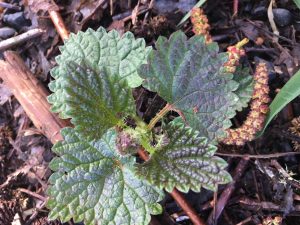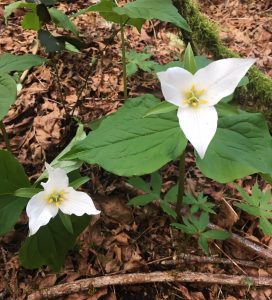Wildcrafting can be a really fun way to learn more about the flora of the PNW as well as gather your own edible plants/mushrooms and medicinal herbs. If you know where to look and how to properly harvest, the Evergreen Woods on campus are a great place for it. Things like morel mushrooms, salmon and thimble berries, Salal (berries can’t be taken in large quantities but the leaves are good for tea and for anti-itch salve), stinging nettle, and mint can all be found on campus. If you don’t know a lot about plant identification, definitely make sure to go with someone who knows what to look for your first few times. Another great resource would be to check out a Native Plant Walk put on by The Native Plant Salvation Foundation at the McLane Creek Nature Trail near campus off of Delphi Road. Beth, the assistant farm manager of the Organic Farm on campus is a part of this group and will often lead the walks. She is a wealth of botanical knowledge!
Early springtime is always great for harvesting stinging nettle. Stinging Nettle (of the Urticaceae or Nettle family). It is most often found in the shady understory of wetter environments but can be found in meadows as well, spreading easily via seed and rhizomes. If you are going to harvest this plant, WEAR GLOVES WHEN HANDLING!! According to Herbal Resource, an online index of medicinal herbs, their uses, and side effects: “the leaves and the stem of the plant are covered with small brittle hairs that break on contact and inject a mixture of histamine, acetylcholine, and 5-hydroxytryptamine, along with small amounts of formic acid, the same substance that makes ant bites sting. This mixture is what produces an inflammatory response in the skin. These chemicals cause pain, numbness, and itching which can last from a few minutes to a day, depending on the sensitivity of the individual.” Further, when harvesting nettle (and most herbs) take only the new growth tips (the first two to three leaf pairs). This allows the plant to regrow as well as ensures you are consuming the freshest, most nutrient-packed part of the plant.

Stinging Nettle
So what is stinging nettle even good for? Well, according to Dr. Mercola nettle contains impressive amounts of vitamins and minerals. Some of the vitamins it contains include vitamins A, C, D, E, and K as well as amino acids and antioxidants. They’re also know to help detoxify the body, promote healthy blood circulation and cardiovascular health, alleviate allergic reactions, and reduce arthritis pain. It is an excellent source of iron and even protein!
Please keep in mind the etiquette of ethical wildcrafting! These principles include always asking permission if on private land, never harvesting all that is available, and if at all possible (and especially if you are harvesting the entire plant, roots and all), bring seeds with you.
Early spring is also an excellent time to see the trillium blooming throughout the woods. Be on the lookout for these delicate three-petaled white flowers all around the main trails to the Puget Sound Beach access via the trailhead from F Lot.

Trillium blooming in the Evergreen Woods
SOURCES:
Stinging Nettle- Herb Uses, Benefits, and Side Effects


Leave a Reply